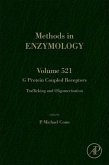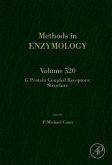Hydrogen Peroxide and Cell Signaling, Part a
Volume 526
Herausgegeben:Packer, Lester; Cadenas, Enrique
Hydrogen Peroxide and Cell Signaling, Part a
Volume 526
Herausgegeben:Packer, Lester; Cadenas, Enrique
- Gebundenes Buch
- Merkliste
- Auf die Merkliste
- Bewerten Bewerten
- Teilen
- Produkt teilen
- Produkterinnerung
- Produkterinnerung
This new volume of Methods in Enzymology continues the legacy of this premier serial with quality chapters authored by leaders in the field. This is the first of three volumes on hydrogen peroxide and cell signaling, and includes chapters on such topics as photooxidation of amplex red to resorufin, boronate-based fluorescent probes, and visualization of intracellular hydrogen peroxide with HyPer.
Andere Kunden interessierten sich auch für
![Hydrogen Peroxide and Cell Signaling, Part B Hydrogen Peroxide and Cell Signaling, Part B]() Hydrogen Peroxide and Cell Signaling, Part B113,99 €
Hydrogen Peroxide and Cell Signaling, Part B113,99 €![Hydrogen Peroxide and Cell Signaling, Part C Hydrogen Peroxide and Cell Signaling, Part C]() Hydrogen Peroxide and Cell Signaling, Part C113,99 €
Hydrogen Peroxide and Cell Signaling, Part C113,99 €![Thiol Redox Transitions in Cell Signaling, Part a Thiol Redox Transitions in Cell Signaling, Part a]() Thiol Redox Transitions in Cell Signaling, Part a121,99 €
Thiol Redox Transitions in Cell Signaling, Part a121,99 €![G Protein Coupled Receptors G Protein Coupled Receptors]() G Protein Coupled Receptors113,99 €
G Protein Coupled Receptors113,99 €![G Protein Coupled Receptors G Protein Coupled Receptors]() G Protein Coupled Receptors113,99 €
G Protein Coupled Receptors113,99 €![G Protein Coupled Receptors G Protein Coupled Receptors]() G Protein Coupled Receptors113,99 €
G Protein Coupled Receptors113,99 €![Reconstituting the Cytoskeleton Reconstituting the Cytoskeleton]() Reconstituting the Cytoskeleton113,99 €
Reconstituting the Cytoskeleton113,99 €-
-
-
This new volume of Methods in Enzymology continues the legacy of this premier serial with quality chapters authored by leaders in the field. This is the first of three volumes on hydrogen peroxide and cell signaling, and includes chapters on such topics as photooxidation of amplex red to resorufin, boronate-based fluorescent probes, and visualization of intracellular hydrogen peroxide with HyPer.
Produktdetails
- Produktdetails
- Methods in Enzymology Volume 526
- Verlag: Academic Press / Elsevier Science & Technology
- Artikelnr. des Verlages: C2012-0-02742-1
- Seitenzahl: 328
- Erscheinungstermin: 8. Juli 2013
- Englisch
- Abmessung: 236mm x 156mm x 25mm
- Gewicht: 690g
- ISBN-13: 9780124058835
- ISBN-10: 0124058833
- Artikelnr.: 38393689
- Methods in Enzymology Volume 526
- Verlag: Academic Press / Elsevier Science & Technology
- Artikelnr. des Verlages: C2012-0-02742-1
- Seitenzahl: 328
- Erscheinungstermin: 8. Juli 2013
- Englisch
- Abmessung: 236mm x 156mm x 25mm
- Gewicht: 690g
- ISBN-13: 9780124058835
- ISBN-10: 0124058833
- Artikelnr.: 38393689
Lester Packer received a PhD in Microbiology and Biochemistry in 1956 from Yale University. In 1961, he joined the University of California at Berkeley serving as Professor of Cell and Molecular Biology until 2000, and then was appointed Adjunct Professor, Pharmacology and Pharmaceutical Sciences, School of Pharmacy at the University of Southern California.
Dr Packer received numerous distinctions including three honorary doctoral degrees, several distinguished Professor appointments. He was awarded Chevalier de l'Ordre National du Merite (Knight of the French National Order of Merit) and later promoted to the rank of Officier. He served as President of the Society for Free Radical Research International (SFRRI), founder and Honorary President of the Oxygen Club of California.
He has edited numerous books and published research; some of the most cited articles have become classics in the field of free radical biology:
Dr Packer is a member of many professional societies and editorial boards. His research elucidated - the Antioxidant Network concept. Exogenous lipoic acid was discovered to be one of the most potent natural antioxidants and placed as the ultimate reductant or in the pecking order of the "Antioxidant Network? regenerating vitamins C and E and stimulating glutathione synthesis, thereby improving the overall cellular antioxidant defense. The Antioxidant Network is a concept addressing the cell's redox status. He established a world-wide network of research programs by supporting and co-organizing conferences on free radical research and redox biology in Asia, Europe, and America.
Dr Packer received numerous distinctions including three honorary doctoral degrees, several distinguished Professor appointments. He was awarded Chevalier de l'Ordre National du Merite (Knight of the French National Order of Merit) and later promoted to the rank of Officier. He served as President of the Society for Free Radical Research International (SFRRI), founder and Honorary President of the Oxygen Club of California.
He has edited numerous books and published research; some of the most cited articles have become classics in the field of free radical biology:
Dr Packer is a member of many professional societies and editorial boards. His research elucidated - the Antioxidant Network concept. Exogenous lipoic acid was discovered to be one of the most potent natural antioxidants and placed as the ultimate reductant or in the pecking order of the "Antioxidant Network? regenerating vitamins C and E and stimulating glutathione synthesis, thereby improving the overall cellular antioxidant defense. The Antioxidant Network is a concept addressing the cell's redox status. He established a world-wide network of research programs by supporting and co-organizing conferences on free radical research and redox biology in Asia, Europe, and America.
- Photooxidation of Amplex Red to Resorufin: Implications of Exposing the Amplex Red Assay to Light
Fiona A. Summers, Baozhong Zhao, Douglas Ganini, and Ronald P. Mason - Boronate-Based Fluorescent Probes: Imaging Hydrogen Peroxide in Living Systems
Vivian S. Lin, Bryan C. Dickinson and Christopher J. Chang - Visualization of Intracellular Hydrogen Peroxide with HyPer, a Genetically Encoded Fluorescent Probe
- In vivo Imaging of H2O2 Production in Drosophila
- Single Fluorescent Probe Distinguishes Hydrogen Peroxide and Nitric Oxide in Cell Imaging
- Electrochemical Biosensors for On-Chip Detection of Oxidative Stress
- Electrochemical Detection of H2O2 Formation in Isolated Mitochondria
- Detection of H2O2 by Fluorescence Correlation Spectroscopy
- Real-Time Monitoring of Reactive Oxygen and Nitrogen Species in a multi-well plate using the diagnostic marker products of specific probes
- H2O2 Delivery to Cells: Steady-State versus Bolus Addition
- Imaging H2O2 Microdomains in Receptor Tyrosine Kinases Signaling
- The Determination aAnd Analysis oOf Site-Specific Rates oOf Mitochondrial Reactive Oxygen Species Production
- A Microfluidic Systems Biology Approach for Live Single-Cell Mitochondrial ROS Imaging
- Detection of Oxidative Damage in Response to Protein Misfolding in the Endoplasmic Reticulum.
- Photooxidation of Amplex Red to Resorufin: Implications of Exposing the Amplex Red Assay to Light
Fiona A. Summers, Baozhong Zhao, Douglas Ganini, and Ronald P. Mason - Boronate-Based Fluorescent Probes: Imaging Hydrogen Peroxide in Living Systems
Vivian S. Lin, Bryan C. Dickinson and Christopher J. Chang - Visualization of Intracellular Hydrogen Peroxide with HyPer, a Genetically Encoded Fluorescent Probe
- In vivo Imaging of H2O2 Production in Drosophila
- Single Fluorescent Probe Distinguishes Hydrogen Peroxide and Nitric Oxide in Cell Imaging
- Electrochemical Biosensors for On-Chip Detection of Oxidative Stress
- Electrochemical Detection of H2O2 Formation in Isolated Mitochondria
- Detection of H2O2 by Fluorescence Correlation Spectroscopy
- Real-Time Monitoring of Reactive Oxygen and Nitrogen Species in a multi-well plate using the diagnostic marker products of specific probes
- H2O2 Delivery to Cells: Steady-State versus Bolus Addition
- Imaging H2O2 Microdomains in Receptor Tyrosine Kinases Signaling
- The Determination aAnd Analysis oOf Site-Specific Rates oOf Mitochondrial Reactive Oxygen Species Production
- A Microfluidic Systems Biology Approach for Live Single-Cell Mitochondrial ROS Imaging
- Detection of Oxidative Damage in Response to Protein Misfolding in the Endoplasmic Reticulum.








